
table of contents
- Rose pests
- Spider mites
- Aphids
- Rose wasp
- Rose petal wasp
- Rose moth
- Rose shoots
- Common rose chafer
- Rose leaf leaf miner
- Rose leaf hippopotamus
- Home remedies for rose pests
- Home remedies from A - D
- Home remedies from K - S
If you are the proud owner of roses, you definitely want to enjoy the beautiful plants for a long time. However, numerous pests can cause an unpleasant surprise when leaves dry up, flowers become blotchy and the roots begin to rot. Rose pests are plentiful and it is important to identify and control them so that you don't have to look after your rose plants for nothing. Suitable home remedies help to contain the infestation.
Rose pests
Pests seek out species of the genus Rosa as a source of food and breeding ground for the larvae and caterpillars because of the numerous plant saps. The number of rose pests is not small and each species can be recognized by specific damage patterns. The damage images are particularly important when analyzing the possible pest, as it is mainly the roots, leaves and flowers that are attacked. That means, without clear symptoms, you won't find out which pest it would be. The sections below will help you identify the pests.
Spider mites
Spider mites are one of the pests that not only owners of roses in the garden notice. The small, spider-like creatures suck the valuable sap from the roses through the leaves and soak in the underside. To recognize
are you experiencing the following symptoms:
- "Cobwebs" on the leaves
- Leaves mottled with yellow
- Leaves dry out
- Plant is weak

You can also spot small arachnids that populate the nets. Spider mites appear in most cases when the following site conditions exist:
- stagnant air
- dry
- warm to hot
- covered
The Tetranychidae can be easily identified if you spray some water on the roses. Then water droplets form on the web. Accordingly, tub roses are a frequent target for mites. You can prevent this problem if you move your plants to an airy or more humid location that is also not covered. This even applies to specimens on the balcony or terrace. There is really nothing more you can do to prevent spider mites.
Aphids
Aphids are just as harmful to the pinks and must be combated. As with other plants, these can be recognized by their way of life:
- Plant parts wither: leaves, buds, shoots
- Traces of suction: dotted or blotchy
- Leaves and buds fall off
- Leaves and buds are misshapen
- Honeydew
Even a small infestation by aphids can be seen immediately, as the animals can be seen with the naked eye. Here, too, the location is to blame for an infestation. Dry, warm locations over the summer are particularly affected. If your roses are weakened to this, a real plague can quickly ensue.
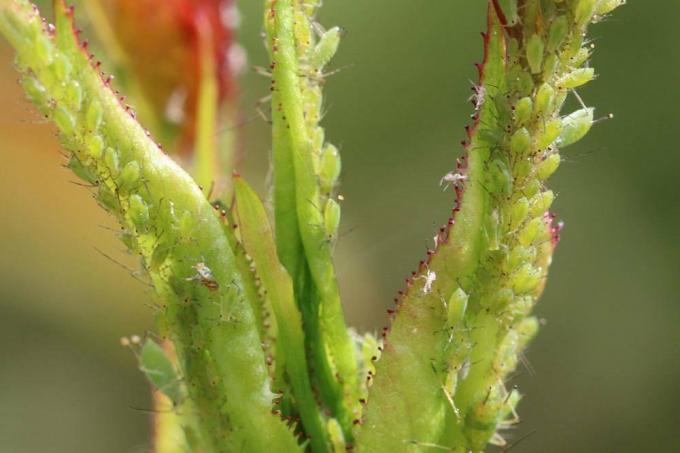
tip: If you have many ants around, you should do something about them. Ants take care of aphids and maintain the population, even if you use suitable home remedies.
Rose wasp
From May to June there can be an infestation with Caliroa aethiops. This is one of the largest leaf pests of the genus Rosa and can be recognized by Rose petals that are eaten off more and more until only the leaf veins remain as a skeleton. The shoots and flowers are usually spared. This cannot be prevented. While the wasps themselves are black and shiny, the larvae have other characteristics:
- green top with yellow belly
- resemble snails in shape
- Length: 1 cm
tip: If you recognize swollen structures with growths on your roses, it will be the rose gall wasp that lays its larva in these structures. The galls aren't really harmful to your rose plants and can be easily removed and disposed of.
Rose petal wasp
Similar to the rose petal wasp, the Blennocampa pusilla attacks the rose petals, only they roll up and thus form a safe haven for the wasp larvae. These stay there from May to early or mid-June until they fall out of the ground. The larvae do not in themselves harm the roses, only a large infestation can weaken the plant somewhat.
tip: In addition to the rose petal wasp, there are other wasp species of the Tenthredinidae that use their roses as a breeding ground for the caterpillars. In most cases, these can be found under the rose petals from May to June and are easy to collect, which significantly reduces the infestation.
Rose moth
This moth is a dangerous pest because it lays its eggs directly in the young shoots of the rose. The larvae hatching from the eggs then eat through the rosewood and weaken it severely. This happens at the end of summer from August to mid-September. If you spot caterpillars on your roses during this time, you need to remove them as soon as possible. Small holes could also be seen on the shoots. The adult, brown animals, on the other hand, eat the following plant parts of the rose:
- Buds
- blossoms
- leaves
- Shoot tips
Rose shoots
Like the rose moth, the rose moth is dangerous for the plants because the larvae feed on the pulp in the shoots. Rose shoot bores can also only be prevented by collecting possible caterpillars, as the infected shoots die off over time. "Drilled holes" can also be seen here. The infestation occurs mainly in May.
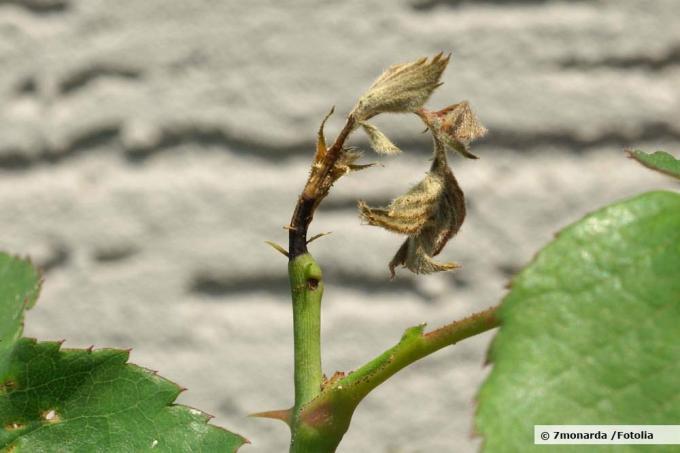
Common rose chafer
Also known as the gold beetle due to the golden yellow spot on its back, it stays in the flowers or on the young shoots and eats the plant material. The damage caused by the feeding behavior is in itself not bad for the roses if only small numbers of gold beetles appear. In particularly hot summers, however, the beetles can flock to your plants in droves. Then you definitely have to fight them. However, you are not allowed to kill the gold beetle. It is under nature protection and can therefore only be relocated. You prevent the infestation by collecting the animals in the early morning hours. During the midday and evening they fly around very quickly, which makes capturing impossible.
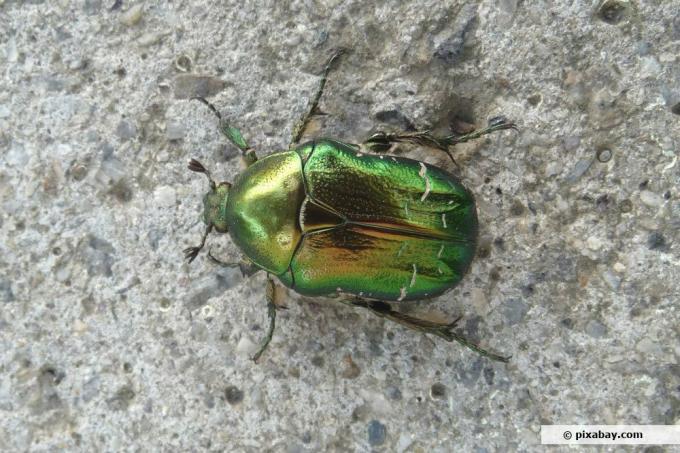
tip: Sometimes roses can be infected by another beetle, the dreaded vine weevil, which is known for its great appetite for ornamental and useful plants. In roses, however, this occurs very rarely and the reason for this is usually another plant nearby that is infested.
Rose leaf leaf miner
You do not have to treat the rose leaf leaf miner itself, as a normal infestation is quite small. The pests can be recognized by the lines on the leaves. These are tunnels that the moth larvae have eaten through the leaf. If you notice an extreme infestation, you should remove as many caterpillars along with the rose petals. This prevents the plants from weakening.

Rose leaf hippopotamus
One of the most famous rose pests is Edwardsiana rosae. The rose leaf hippopotamus is characterized by a similar feeding behavior, but does not form webs and in case of danger the insects hop away. They can be recognized by the following features:
- Color: light green, yellow green
- big wings
- rarely in groups
The cicadas mainly appear when the location is hot. Two times a year are particularly worth mentioning here:
- End of May to mid-July
- Mid-August to mid-September
On the second appointment, the insects lay their eggs in the rose shoots and multiply in this way. For this reason, scare away the cicadas as best you can so that you don't have to fight them for the next year.

Home remedies for rose pests
You do not have to fight rose pests immediately with pesticides. These often even have a negative effect on the crops and should only be used in the most extreme cases. One example is the rose petal wasp infestation. This can only be fought with appropriate means. For all other pests, make use of the following home remedies. These aren't even harmful to your roses:
Home remedies from A - D
Collecting
One of the most effective home remedies to get rid of the pests is to collect the caterpillars and larvae. Of course, this is not possible with aphids, but it is extremely efficient with the other visible pests. As soon as you have collected the caterpillars and larvae, you should dispose of them in the general waste or move them far away from your garden if you do not want to kill them immediately.
Remove infected parts of the plant
An incipient plague from insects such as rose wasps can be easily removed by removing the infected parts of the plant. If the shoots, leaves and flowers are populated by the pests, use scissors and then dispose of the clippings in the residual waste. The larvae of many pests can survive on the compost.
Nettle stock
Hire one Nettle stock from one kilogram of nettles and five liters of water. Pour all of these ingredients into a barrel or container and let the mixture steep for three days. Then spray the brew undiluted directly onto the pests. Since this is not nettle manure, it is not necessary to dilute it. Particularly effective against rose aphids.
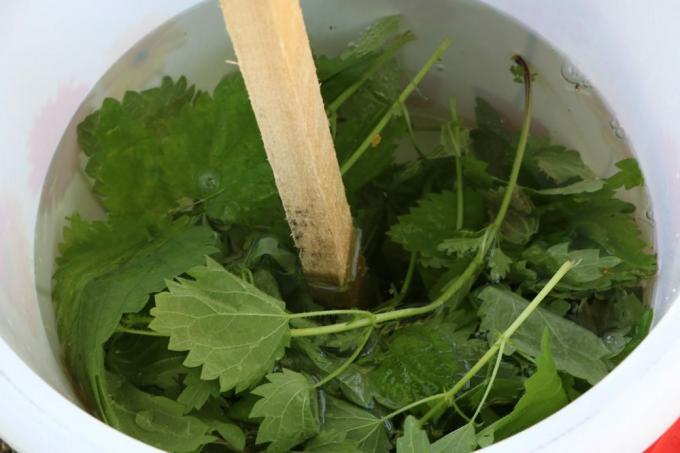
shower
Roses are impervious to high water pressure and for this reason you can use a shower as a home remedy for pests such as spider mites. To do this, spray the undersides of the leaves and the infected shoots with the garden hose to remove the pests.
Home remedies from K - S
Herbs
Plant herbs between the roses. Herbs such as sage (bot. Salvia), mint (bot. Mentha) and basil act effectively as a barrier against a large number of rose pests and prevent rapid spread in the event of an infestation due to the greater distance between the specimens. You can also use garlic (bot. Allium sativum) and other leek plants.
Neem oil
Neem oil has established itself as a good home remedy for many harmful insects and can also be used against a large number of pink pests. To do this, mix some of the oil into the water for pouring. This is how pests like vine weevils and rose wasps stay away. If you make a spray from neem oil and water, you can use it to fight aphids, for example.
Soapy solution
Mix two liters of water, 100 grams of curd soap and 150 milliliters of alcohol to form a spray. You then apply this to the infected parts of the plant, especially the leaves. You should not spray flowers with this agent, as they are too sensitive to the ingredients. It works in a similar way to neem oil.
Natural predators
You can use appropriate predators against a large number of pests. While this is not really a home remedy, you don't have to rely on chemistry for it. Many of the caterpillars can be done, for example, when you settle birds or hedgehogs. Ladybirds, predatory mites, lacewings, predatory bugs, gall midges and ear peasants should also be mentioned, which even eat adult specimens of the rose pests.
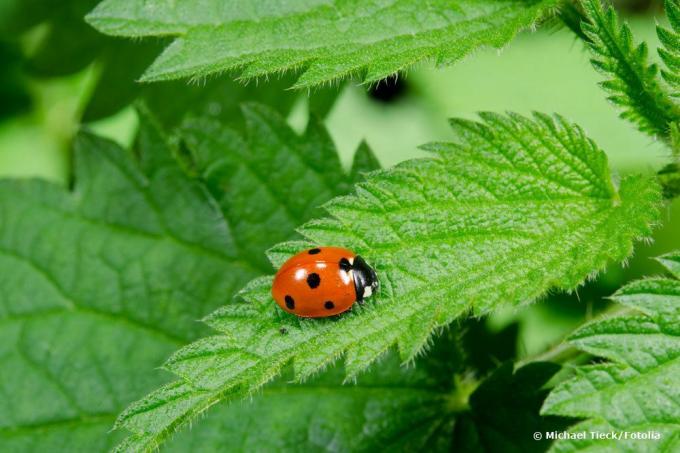
It is also advisable to choose resistant rose varieties. These are only visited by pests in exceptional cases and are therefore ideal for your garden. Above all, healthy ADR varieties should be mentioned.
tip: Regular pruning is also particularly effective, because if roses are neglected, they are the ideal habitat for numerous harmful insects. Above all, a strong pruning in spring and autumn must be taken into account, as the vitality and thus the resistance to pests are preserved.


